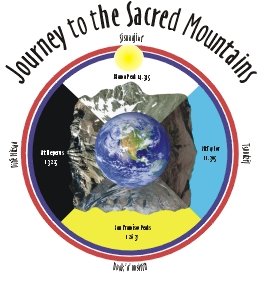
Named The San Francisco Peaks by 17th century Franciscan missionaries, Dook’o’oosłíí is the Navajo Sacred Mountain that marks the western boarder of traditional Navajo homeland. Represented by the color yellow, Navajo describe that Dook’o’oosłíí is representative of adulthood and associated with Autumn. Secured to the earth by a sun beam and containing abalone shell inside, it is the home of Haashch’éélt’i’í Talking God, Naada’algaii ‘Ashkii White Corn Boy, and Naadá ‘Altsoii ‘At’ééd Yellow Corn Girl. It has a female attribute and said to be covered with yellow clouds mixed with evening twilight.
In western terms, "The Peaks" are volcanic in origin, and stand a mile above the surrounding southwestern edge of the Colorado Plateau. A series of 6 peaks standing above 11,000 feet border the volcanic caldera that makes up the Inner Basin. Humphreys Peak stands at 12,366 feet and marks the highest point in Arizona. The four highest individual peaks in Arizona are contained within the range.
At least 13 Native American tribes describe sacred connections to these mountains. Navajo, Hopi, Zuni, Apache, Acoma, Southern Paiute, Havasupai, Hualapai, Yavapai, and Mojave are among the indigenous people who have ancestral ties to these sacred peaks which have provided life sustaining water, game, timber, medicinal plants, and spiritual context throughout their history.
In modern times, conflicts and controversy have been ongoing as industrial and recreational interests have pursued development that has been seen as contrary to the spiritual nature of these sacred mountains. Journey to the Sacred Mountains has no direct connection or involvement in these disputes, as a cultural awareness project, we endeavored to approach these sacred peaks with the utmost respect and reverence for their sacred significance.
Our journey took us to Dook’o’oosłíí on Saturday October 17, 2009.
Photos from the trip can be seen here.

No comments:
Post a Comment